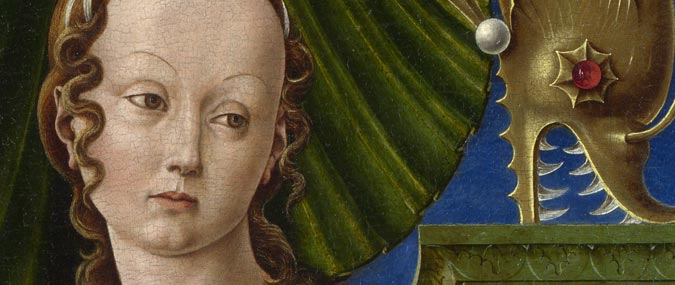Bacchus and Ariadne
Listen to Jill Dunkerton from the Conservation Department talk about Titian's masterpiece, Bacchus and Ariadne.
Find out how surprised people were in the 1960s when the thick, amber coloured varnish was cleaned off to reveal Titian's bright colours.
Art in the Making: Bacchus and Ariadne
Transcript
Female Voice: Probably in the late 16th century, this very famous painting by Titian had been taken off its wooden stretcher and the canvas rolled so it could be transported to Rome.
Jill Dunkerton is a paintings restorer in the National Gallery’s Conservation Department.
Jill Dunkerton: The rolling of the canvas caused severe cracking, particularly in the sky. And because these early canvases were prepared with gesso, which isn’t very flexible, it obviously just ‘pinged’ off, taking paint with it. So the sky, sadly, is quite badly damaged.
However, considering what’s happened to this painting in the past, there are large areas which are in very good condition: most of the lower part and the trees over on the right. And it’s here we see Titian’s exuberant use of colour.
Before the painting was cleaned back in the 1960s, it was covered in a very, very thick, almost amber-coloured varnish, which of course was what people had come to think of Titians as looking like. So it was an astonishing surprise and really a shock to some people to discover how intensely-coloured it was.
One of the exciting things about paintings by the young Titian, and indeed his other Venetian contemporaries, is how they began to see how you could use oil paint in a much more expressive, bold way. You stop worrying about whether your brushstrokes are showing or not: you actually make that part of the feature of painting.
When using colours which have got quite a lot of solid texture – for example the lead-tin yellow of the yellow fabric bundled down in the left corner or the white sleeve of Ariadne on the left – he really exploits the bulk of the paint and he loves the buttery quality of the paint when you mix the pigment with oil. He’s putting it on with these long sweeping bold strokes and it’s very exciting to see throughout Titian’s career how he develops this love of paint as a material.
Female Voice: In the lower-left corner, notice the sheen of the metal urns set against the fabric, contrasted against the furry legs of the boy in the middle and a dog.
Jill Dunkerton: He must have adored animals. He painted dogs with incredible affection but also with an astonishing observation of their behaviour. But above all it’s the texture of their fur that he loved to paint.
Female Voice: What perhaps stands out most in the composition is the use of that incredibly rich blue. It’s pure ultramarine, derived from grinding lapis lazuli, a semi-precious stone.
Next: The Entombment


